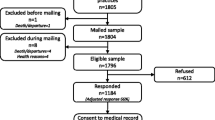Abstract
We explored the predictors of foot ulceration in patients with rheumatoid arthritis (RA). The cases were 15 patients with RA reporting foot ulceration in response to a postal survey of patients sampled from a diagnostic register in secondary care (n = 1,130). The controls were 66 patients with RA randomly sampled from the survey respondents (n = 883) after matching for age, sex and disease duration. Patients with co-existent diabetes were excluded. Clinical examination included the assessment of known risk factors for foot ulceration in diabetes including: neuropathy (insensitivity to 10 g monofilament), peripheral vascular disease (ankle brachial pressure index [ABPI]), foot deformity (Platto indices) and raised plantar pressure (PressureStat™ readings). A 44 swollen-joint count, the presence of pre-ulcerative lesions and current steroid therapy were identified through univariate analysis as additional potential predictors in patients with RA. Forward step-wise logistic regression analysis showed that the following variables were significant predictors of ulceration: steroid therapy (OR = 9.70, 95%CI = 2.09–45.11, p = 0.004), abnormal ABPI (OR = 13.45, 95%CI = 1.19–151.43, p = 0.035), the presence of pre-ulcerative lesions (OR = 7.40, 95%CI = 1.51–36.30, p = 0.014) and swollen-joint count (OR = 1.25, 95%CI = 1.02–1.53, p = 0.034). Abnormal sensation, foot deformity and raised plantar pressures were not significant predictors of ulceration. The wide confidence intervals for ABPI were due to sparse data with very few abnormal values, and the results of exact logistic regression (more accurate where data is sparse and case matching employed) found that ABPI was no longer a significant predictor (p = 0.054). The significance of the other predictors did not differ substantially. In this preliminary study, abnormal sensation, foot deformity and raised plantar pressures were not significantly associated with foot ulceration but active disease and current steroid therapy were. The contribution of peripheral vascular disease to risk is unclear and further investigation is needed in a larger cohort.
Similar content being viewed by others

References
Firth J, Hale CA, Helliwell PS, Hill J, Nelson EA (2008) The prevalence of foot ulceration in patients with rheumatoid arthritis. Arthritis Rheum 59(2):200–205
Matricali GA, Boonen A, Verduyckt J, Taelman V, Verschueren P, Sileghem A, Corluy L, Westhovens R (2006) The presence of forefoot problems and the role of surgery in patients with rheumatoid arthritis. Ann Rheum Dis 65(9):1254–1255
Boulton AJ (2000) The pathway to ulceration. In: Boulton AJM, Connor H, Cavanagh PR (eds) The foot in diabetes. Wiley, London
Platto MJ, O’Connell PG, Hicks JE, Gerber LH (1991) The relationship of pain and deformity of the rheumatoid foot to gait and an index of functional ambulation. J Rheumatol 18(1):38–43
Garrow AP, Papageorgiou A, Silman AJ, Thomas E, Jayson MIV, Macfarlane GJ (2001) The grading of Hallux Valgus: the manchester scale. J Am Podiatr Med Assoc 91(2):74–78
Helliwell PS, Reay N, Gilworth G, Redmond A, Slade A, Tennant A, Woodburn J (2005) Development of a foot impact scale for rheumatoid arthritis. Arthritis Rheum 53(3):418–422
Kirwan JR, Reeback JS (1986) Stanford health assessment questionnaire modified to assess disability in British patients with rheumatoid arthritis. Br J Rheumatol 25:206–209
Maradit-Kremers H, Nicola PJ, Crowson CS, Ballman KV, Gabriel SE (2005) Cardiovascular death in rheumatoid arthritis. Arthritis Rheum 52(3):722–732
Alkaabi JK, Ho M, Levison R, Pullar T, Belch JJ (2003) Rheumatoid arthritis and macrovascular disease. Rheumatology 42(2):292–297
Anstead GM (1998) Steroids, retinoids, and wound healing. Adv Wound Care 11:277–285
Wilson O, Kirwan JR (2006) Measuring sensation in the feet of patients with rheumatoid arthritis. Musculoskeletal Care 4(1):12–23
Lavery LA, Armstrong DG, Vela SA, Quebedeaux TL, Fleischli JG (1998) Practical criteria for screening patients at high risk for diabetic foot ulceration. Arch Intern Med 158(2):157–162
Murray HJ, Young MJ, Hollis S, Boulton AJ (1996) The association between callus formation, high pressures and neuropathy in diabetic foot ulceration. Diabet Med 13(11):979–982
Veves A, Murray HJ, Young MJ, Boulton AJM (1992) The risk of foot ulceration in diabetic patients with high foot pressure: a prospective study. Diabetologia 35:660–663
Collis WJMF, Jayson MIV (1972) Measurement of pedal pressures: An illustration of a method. Ann Rheum Dis 31:215–217
Minns RJ, Craxford AD (1984) Pressure under the forefoot in rheumatoid arthritis. A comparison of static and dynamic methods of assessment. Clin Orthop Relat Res 187:235–242
Tuna H, Birtane M, Tastekin N, Kokino S (2005) Pedobarography and its relation to radiologic erosion scores in rheumatoid arthritis. Rheumatol Int 26:42–47
Woodburn J, Helliwell PS (1996) Relation between heel position and the distribution of forefoot plantar pressures and skin callosities in rheumatoid arthritis. Ann Rheum Dis 55(11):806–810
Elwood M (1998) Critical appraisal of epidemiological studies and clinical trials, 2nd edn. Oxford University Press, Oxford
Funding
This work was funded by the award of a Doctoral Nursing Studentship to Jill Firth from the Smith and Nephew Foundation. Dr. Firth is currently the recipient of the Smith and Nephew Post Doctoral Research Fellowship.
Disclosures
No disclosures.
Author information
Authors and Affiliations
Corresponding author
Rights and permissions
About this article
Cite this article
Firth, J., Helliwell, P., Hale, C. et al. The predictors of foot ulceration in patients with rheumatoid arthritis: a preliminary investigation. Clin Rheumatol 27, 1423–1428 (2008). https://doi.org/10.1007/s10067-008-0940-y
Received:
Revised:
Accepted:
Published:
Issue Date:
DOI: https://doi.org/10.1007/s10067-008-0940-y


